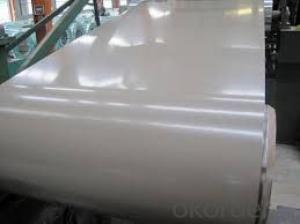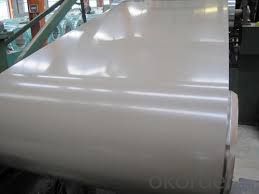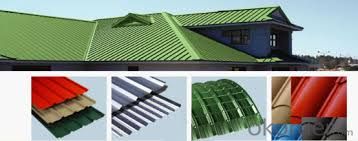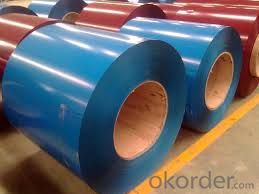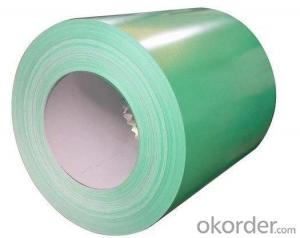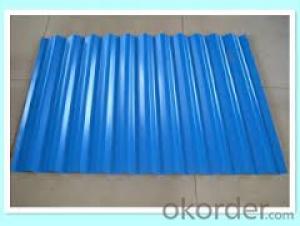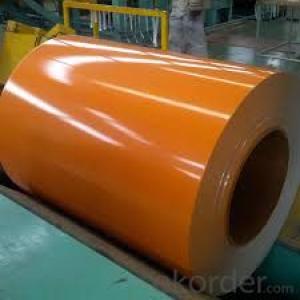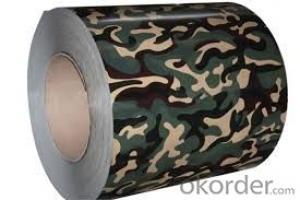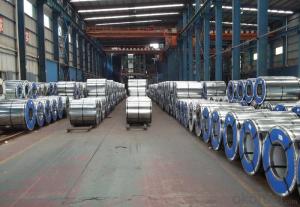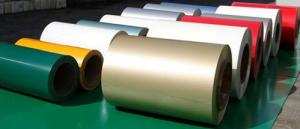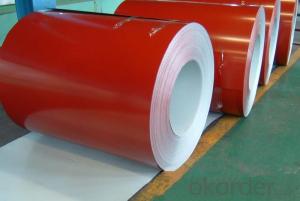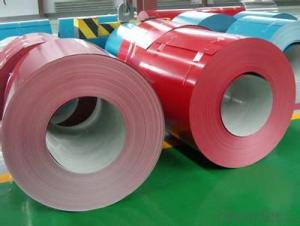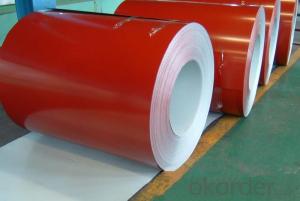pre-painted Steel Rolled/Prepainted Cold Rolled Galvanized Steel Sheet Coil
- Loading Port:
- China main port
- Payment Terms:
- TT OR LC
- Min Order Qty:
- 25 m.t.
- Supply Capability:
- 1000 m.t./month
OKorder Service Pledge
OKorder Financial Service
You Might Also Like
Product Description
Product | Galvanized | PPGI | Contour plate
| Camouflage plate | |
Certificate | ISO9001,ISO14001 | ||||
Standard | ASTM A526 JIS G3302 | ASTM A525 JIS G3312/3322 | - - | - - | |
Gade | CGCC/CGLCC CGCH/CGLCH CGC340-570 CGLC400-570 | SGCC/CS/DX51D SGCH | - - - - | - - - - | |
Model | Thick:0.11-1.0mm Width:600-1250mm | Thick:0.14-3.5mm Width:600-1250mm | Thick:0.14-3.0mm Width:600-1250mm | Thick:0.14-3.5mm Width:600-1250mm | |
Type | Roil/Coil Sheet/Plate Corrugated Sheet | Roil/Coil Sheet/Plate Corrugated Sheet |
Corrugated Sheet | Roil/Coil Sheet/Plate Corrugated Sheet | |
Coil Weight | 3-8t | ||||
Surface Finish | Regular Spangle | Pre-painted | Pre-painted | Pre-painted | |
Application | Roofing,Structural,Commercial use,Household Applicnce,Industry,Others | ||||
Special Application
| Wear resdentant steel,High-strength-steel plate | ||||
Name | GI / GL / PPGI / PPGL |
Full name | Galvanized ,Galvalume,Pre-paited galvanizing,Pre-paited galvalume |
Basic material | Cold Roll |
Color of the PPGI and PPGL | Any color in RAL |
Standard | AISI, ASTM, BS, DIN, GB, JIS |
Spangle | Normal / Min / Zero |
Brand Name | |
Thickness | 0.6mm |
Width | 600mm to 1250mm |
Length | According to customers |
Surface Treatment | Hop-dipped Galvanized |
AZ coating | 50-275g/m2 |
Spangle | Normal/Min/Zero |
Minimum order | 25 Metric Tons |
Place of Origin | Shandong, China(Mainland) |
Packing | Fully Applicable for exporting seaworthy packing of horizontal type on wooden skids |
Price terms | FOB Qingdao |
Terms of payment | T/T, L/C or T/T and L/C |
Delivery Detail | within 7-25 days after receiving pre-payment (as per the order quantity) |
Coil ID | 508mm/610mm |
Coil Weight | 3-5 tons |
Supply Ability | 30000MT per month |
Application | Construction Structure, roofing, commercial use, household appliance, industry- |
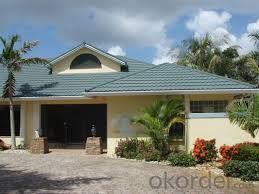
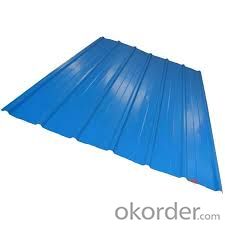
- Q: what happened to all the steel beams from the WTC buildings? did anyone do any forensic analysisof any of the steel?
- Some of the steel was recycled for sale to other countries where they aren't so picky about reusing building materials. NIST had 200 pieces of the steel for their investigation, which they returned last year. This was covered in the press. The rest of the steel was held at JFK international airport's Hangar 17. Much of it will be placed/has been placed in the new museum beneath the Memorial at the WTC site. Thousands of pieces are being given out for 9/11 memorials all over the world. Just about every day you read in the newspaper about another piece going here or there to this city or that city. Yes, a lot of the steel was tested for a number of chemical compounds. It had to be for safety reasons before storing it and giving it out. Depending upon what countries the recycled beams were sent to and their rules, it was sometimes tested at the ports of entry over there, as well.
- Q: 7850kg/cu.m density is typical for all type of steel? like reibar, I- beam and so on
- 90% of the steels used today are plain mild carbon steels consisting of iron with less than 1% carbon content and as such have a density of about 7750 kg/cubic meter. Some special steels which have a significant percentage of alloying elements such as chrome or manganese or other elements will have greater density bringing the steel up to about 8000 kg / cubic meter. There are a greater many factors influencing the exact density of a steel. Even for steels of exactly the same content of iron , carbon and other alloying elements, there may be a difference ( very small mind you ) in density due to work hardening. The difference in this case is due to movement of dislocations which become locked in the grain boundaries and this forms a more dense crystal structure. For this same reason, the theoretical density of steel (which does not take into account dislocations) is greater than the measured density of steel.
- Q: What are the different types of steel coil edge finishes?
- There are several types of steel coil edge finishes, including mill edge, slit edge, and sheared edge. Mill edge refers to the natural, untreated edge of the steel coil as it comes from the mill. Slit edge is created when the coil is slit into narrower widths, resulting in a smooth, burr-free edge. Sheared edge is produced when the coil is cut using mechanical shearing, resulting in a slightly rougher edge compared to slit edge.
- Q: help me and my twin love this cutie in our form !? how do we steel hime from bitchey rebecca!? X X X xX
- Well i never had to steel a guy because if I have to go through all of that obviously hes not for me. Also, I never been that desperate. But if you can steel the boy your going to share him with your twin? thats not very... normal. Also if you can steel the guy, how long do you think hes going to stay with you before someone else takes him. Also you should read more so you can spell better because cute guys try to take advantage of dumb girls.
- Q: What are the common coil thicknesses available for steel coils?
- The common coil thicknesses available for steel coils can vary depending on the specific application and industry requirements. However, some of the most common coil thicknesses for steel coils range from 0.5mm to 3mm. These thicknesses are commonly used in various manufacturing processes, including automotive, construction, and appliance industries. For lightweight applications or where flexibility is required, thinner steel coils with thicknesses ranging from 0.5mm to 1.5mm are often used. These thinner coils are suitable for applications such as automotive body panels, roofing, and general sheet metal fabrication. On the other hand, for applications that require higher strength and durability, thicker steel coils with thicknesses ranging from 1.5mm to 3mm are commonly used. These thicker coils are often utilized in heavy-duty construction, structural components, and industrial equipment manufacturing. It is important to note that these are just general ranges, and specific coil thicknesses can vary depending on the specific requirements of a particular project or customer preference. Steel coil thicknesses can be customized to meet specific needs, allowing for greater flexibility in various industries.
- Q: I am reading the book The Cure For All Advanced Cancers by Hulda Regehr Clark.She writes for example: cancer can be caused by exposure to heavy metals, like nickel and chromium from stainless steel cookware. Stainless steel cookware releases chromium and nickel, two of the most carcinogenic metals.Are there any studies done measuring how much nickel and cadmium can be released from the regular use of stainless steel cookware?Is this a commonly accepted opinion that use of stainless steel cookware is dangerous?If not stainless steel, what kind of cookware to use? I heard that non-stick cookware also releases some harmful chemicals.
- Hi, I think that Stainless Steel is one of the safest ways to cook food. Glassware is also safe, but you must be careful not to drop the stuff, it can break and leave small pieces on the floor. Yes non-stick cookware can harm small fast breathing animals like birds in your house if the cookware overheats, but by keeping water or moisture in the bottom of the pan, and not using supper high heat, you can avoid overheating a non-stick surface. This also includes not scraping the surface with the utensils. Aluminum cookware, especially cast aluminum is considered by many as more than average toxic to many. Test for alltimers is that they contain aluminum in their bodies, and many owned aluminum cookware too. To kill cancer, look to Dr. Otto Warburg, who did win a Noble Prize for discovering how to kill the cancer cells.
- Q: How are steel coils protected from extreme weather conditions?
- Steel coils are typically protected from extreme weather conditions using various methods such as covering them with waterproof wraps, storing them in climate-controlled warehouses, or applying anti-corrosion coatings. These measures ensure that the coils are shielded from moisture, temperature fluctuations, and other environmental factors that could potentially damage or degrade the steel.
- Q: What are the different types of steel coil surface treatments for durability?
- There are several different types of steel coil surface treatments that can enhance the durability of the material. 1. Hot-dip galvanizing: This process involves immersing the steel coil in a bath of molten zinc, creating a protective zinc coating on the surface. Hot-dip galvanizing provides excellent corrosion resistance and can extend the lifespan of the steel coil. 2. Electro-galvanizing: In this method, a thin layer of zinc is electrodeposited onto the surface of the steel coil. Electro-galvanizing offers good corrosion resistance and is commonly used for indoor applications or where a thinner coating is desired. 3. Powder coating: Powder coating involves applying a dry powder paint to the surface of the steel coil and then curing it under heat. This creates a durable, uniform, and attractive finish that is resistant to chipping, scratching, and fading. 4. Organic coatings: Organic coatings, such as acrylics, polyesters, or fluoropolymers, are often applied to steel coils to provide protection against corrosion, UV rays, and other environmental factors. These coatings can enhance the durability and aesthetics of the steel coil. 5. Chromate conversion coating: This treatment involves applying a thin layer of chromate onto the surface of the steel coil. Chromate conversion coatings provide corrosion resistance and can improve the adhesion of subsequent paint or powder coating layers. Each of these surface treatments offers unique benefits in terms of corrosion resistance, durability, and appearance. The choice of treatment depends on the specific application requirements and the level of protection needed for the steel coil.
- Q: Please explain why steel is denser than wood.
- Steel is basically a mixture (not the compound) of iron and carbon. Iron, by itself is an element and so is carbon. The atoms of Iron are larger in size compared to carbon. All the atoms of all the elements, smaller or larger, are spherical. If naturally a solid, the atoms of all such elements have voids as their atoms are closely packed. You can imagine a basket of oranges; you could see that void or empty space (which I am speaking about) between four or more of the oranges put together. Now, when heated to more than about 1500 degrees celcius, Iron melts and atoms in molten form increase space between themselves. Raising the teperature to 1800 degree celcius, carbon is mixed with iron. At this stage it causes the spherical carbon atoms to fill in the spaces present amongst the spherical atoms of the iron. On cooling, already dense iron becomes denser because no space is left there between its atoms. This denser form of iron + carbon has become steel in which carbon is not more than 3 to 4% of the total volume. Wood is nothing but a fallen and dried tree's part. When green and alive, tree's stem and branches have pores in there texture, which are fillled with water and other biological fluids necessary for the life of the plant. When dried all the fluids, especially water gets evaporated. and the pore are empty now. The term Density, means mass divided by volume (kg / cubic meters). Iron + Carbon (the steel) so tightly packed and Iron having very high atomic weight is surely denser than wood with just carbon and a few other elements with no significant role to play in the mass calculation; particularly if their are empty pore spaces filled with air only. Imagine the mass (which common people mistakingly call the weight) in kilograms of a peice of steel with dimensions of 1 meter cube and imagine the same for the dried wood. What do you think---which one is denser?
- Q: In what ways can steel fail in use of buildings ad what can be done to prevent it?
- First let us see what steel is made from. PIG IRON, which is put into a blast furnace with other things to get the impurities out. the very high grated of steed include TUNGSTEN CARBIDE STEEL, which is used to make tooling. down to lower grades of steel to make other things. the stronger the steel that is required the less impurities that are in it. different steels are treated with different elements depending on what the steel is going to be used for, So if steel is Incorporated into a building and say the building caught fire enough heat could be produced to actually soften the steel and result in failure. hope this helps. Dr Knowitall.
Send your message to us
pre-painted Steel Rolled/Prepainted Cold Rolled Galvanized Steel Sheet Coil
- Loading Port:
- China main port
- Payment Terms:
- TT OR LC
- Min Order Qty:
- 25 m.t.
- Supply Capability:
- 1000 m.t./month
OKorder Service Pledge
OKorder Financial Service
Similar products
Hot products
Hot Searches
Related keywords
